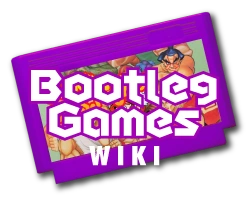Cheetahmen92 (talk | contribs) (An attempt to fix the translation) |
No edit summary |
||
| Line 5: | Line 5: | ||
The Phantom System possessed the same platform 8-bit of the Nintendo, and the 72-pin cartridges the NES used. It was possible, however, to insert Famicom cartridges which were 60-pin, but this could only be done with the use of an adapter. The Phantom had a controller with a similar model used for the Sega Mega Drive,<sup class="reference" id="cite_ref-0">[http://www.microsofttranslator.com/bv.aspx?from=&to=en&a=http%3A%2F%2Fpt.wikipedia.org%2Fwiki%2FPhantom_System%23cite_note-0]</sup> and usually the consumer had, at the time of purchase, a cartridge came with the console. The games which accompanied the console could be ''Ghostbusters'', ''Super Pitfall'', ''Gauntlet'' or ''Schwarzenegger´s Predator'', all of which were officially licensed by Activision and [[Tengen]]. |
The Phantom System possessed the same platform 8-bit of the Nintendo, and the 72-pin cartridges the NES used. It was possible, however, to insert Famicom cartridges which were 60-pin, but this could only be done with the use of an adapter. The Phantom had a controller with a similar model used for the Sega Mega Drive,<sup class="reference" id="cite_ref-0">[http://www.microsofttranslator.com/bv.aspx?from=&to=en&a=http%3A%2F%2Fpt.wikipedia.org%2Fwiki%2FPhantom_System%23cite_note-0]</sup> and usually the consumer had, at the time of purchase, a cartridge came with the console. The games which accompanied the console could be ''Ghostbusters'', ''Super Pitfall'', ''Gauntlet'' or ''Schwarzenegger´s Predator'', all of which were officially licensed by Activision and [[Tengen]]. |
||
| − | In reality, Gradiente had plans to launch the |
+ | In reality, Gradiente had plans to launch the Atari 7800 in Brazil , but after seeing public interest about the Atari games fade and clones for the NES increase in popularity with the release of Dynavision 2 by [[Dynacom]], they decided to change the system to a NES clone while keeping the external appearance. |
| + | ==sfsdfwerf== |
||
| − | work in progress |
||
| + | What few people know is that the Atari 7800 was almost released in Brazil. The Gradient Group, copyright holder under the brand Atari in Brazil at the time of the announcement, came to renew the rights under the brand name for the production of the Atari 7800. However, afraid of recent failures with the Atari 5200, which came to be manufactured in Brazil at the expense of increased production of Atari 2600, which was quite long in Brazil, and if and when very low success of the 5200 in the USA and Europe, thye chose not to renew the detention of the Atari brand and not produce the new console Atari 7800 by choosing to produce the Phantom System, clone of the NES was phenomenon throughout the world and produce games licensed by Nintendo in Brazil. However, with the whole assembly line ready to produce the Atari 7800 option was to maintain the carcass of the Atari 7800 hardware with all Nintendo adapted. See the photo of the Atari 7800 and proves that the shell was the same. |
||
[[Category:Famiclones]] |
[[Category:Famiclones]] |
||
Revision as of 09:35, 28 May 2011
Note: the artcile may not be translated propely. An effort has been made to insure that there are as few translation errors as possible however some of this stuff is very hard to translate some things so it would be nice if you help out.
The Phantom System was the first Brazilian famiclone, released by Gradiente during the end of the 1980s, and was compatible with NES cartridges. This console can therefore be considered a clone of the NES, at least in technical aspects. Gradiente launched it at a time when Nintendo didn't show any interest in launching the NES in Brazil. Therefore, they pounced and launched the Phantom System to meet a growing demand for a community of avid gamers looking for new systems, with the market being saturated with Atari 2600 clones. The Phantom System eventually became the most popular NES clone in Brazil.
The Phantom System possessed the same platform 8-bit of the Nintendo, and the 72-pin cartridges the NES used. It was possible, however, to insert Famicom cartridges which were 60-pin, but this could only be done with the use of an adapter. The Phantom had a controller with a similar model used for the Sega Mega Drive,[1] and usually the consumer had, at the time of purchase, a cartridge came with the console. The games which accompanied the console could be Ghostbusters, Super Pitfall, Gauntlet or Schwarzenegger´s Predator, all of which were officially licensed by Activision and Tengen.
In reality, Gradiente had plans to launch the Atari 7800 in Brazil , but after seeing public interest about the Atari games fade and clones for the NES increase in popularity with the release of Dynavision 2 by Dynacom, they decided to change the system to a NES clone while keeping the external appearance.
sfsdfwerf
What few people know is that the Atari 7800 was almost released in Brazil. The Gradient Group, copyright holder under the brand Atari in Brazil at the time of the announcement, came to renew the rights under the brand name for the production of the Atari 7800. However, afraid of recent failures with the Atari 5200, which came to be manufactured in Brazil at the expense of increased production of Atari 2600, which was quite long in Brazil, and if and when very low success of the 5200 in the USA and Europe, thye chose not to renew the detention of the Atari brand and not produce the new console Atari 7800 by choosing to produce the Phantom System, clone of the NES was phenomenon throughout the world and produce games licensed by Nintendo in Brazil. However, with the whole assembly line ready to produce the Atari 7800 option was to maintain the carcass of the Atari 7800 hardware with all Nintendo adapted. See the photo of the Atari 7800 and proves that the shell was the same.
